 ?Mathematical formulae have been encoded as MathML and are displayed in this HTML version using MathJax in order to improve their display. Uncheck the box to turn MathJax off. This feature requires Javascript. Click on a formula to zoom.
?Mathematical formulae have been encoded as MathML and are displayed in this HTML version using MathJax in order to improve their display. Uncheck the box to turn MathJax off. This feature requires Javascript. Click on a formula to zoom.Abstract
Dynamical properties of dust-ion-acoustic waves (DIAWs) are analysed in a collisional nonextensive dusty plasma composing of mobile ions, q-nonextensive electrons and stationary dust grains with slight collisions between dusts and ions. Reductive perturbation technique (RPT) is practiced to acquire the damped Korteweg-de Vries (DKdV) equation. In absence of collision between dusts and ions, the damping term vanishes and the DKdV equation reduces to the KdV equation. Bifurcation analysis of the dynamical system obtained from the KdV equation is carried out. Analytical solitary wave solution and numerical periodic wave solution of the KdV equation are presented. Approximate analytical DIAW solutions for the DKdV equation are furnished using the novel -expansion technique. As an outcome, novel approximate analytical solutions of DIAWs are obtained for the DKdV equation. The application of our work is significant to explore nonextensive plasma environment, such as, ionosphere of Earth.
1. Introduction
The interpretation of DIAWs in dusty plasmas has been a rapidly growing research area for last few decades [Citation1, Citation2]. Some interesting works have been reported in various areas of plasma environments, namely, ring of planets, plasma or gas tails, interplanetary state, interstellar clouds, and the Earth's ionosphere [Citation3, Citation4]. The presence of dust particles in dusty plasmas initiates new novel eigenmodes, for example, dust-acoustic wave, DIAW, dust lattice mode, etc. It is important to note that dust particles are negatively charged and taken as immobile because of their weighty concentration [Citation5]. With rise in electron population, the DIAW phase velocity diminishes [Citation6, Citation7]. Recently, DIAWs were examined in both cases theoretically and practically. DIAW was also examined in collisionless [Citation8] plasma as a limiting situation, but it is not well framed in some real situations [Citation9]. Ghosh et al. [Citation10] reported influence of damping on DIAWs. Losseva et al. [Citation11] investigated evolution of weakly dissipative hybrid DIA solitary wave in a collisional plasma. The work [Citation12] reported the impacts of fluctuation of dust charge on soliton of the modified KdV-Burger equation in dusty plasmas. Popel et al. [Citation13] examined experimentally that wave speed is much greater than the wave speed of theoretical situation. Losseva et al. [Citation14] examined arbitrary amplitude DIAWs in dusty plasma. Kruskal [Citation15] reported that gravity wave in inviscid fluid can be modelled the KdV equation asymptotically. Some researchers theoretically and experimentally studied solitary and shock DIAWs [Citation16–19] in dusty plasmas. Ashraf et al. [Citation20] reported behaviours of obliquely travelling DIAWs in a nonextensive dusty plasma. Bacha et al. [Citation21] reported DIAW solitons in non-Maxwellian dusty plasmas. Tribeche and Zerguini [Citation22] investigated DIAWs with effects of undulations of dust charge and instability in a collisional dusty plasma. Later, it was reported that the plasma system having Gaussian distributed dust grains supports DIAW soliton feature in presence of collisional effect [Citation23]. Similarly, works [Citation24–27] reported the solution of the damped KdV equation in different plasma systems through the classical approach.
The -expansion technique was discovered by Wang et al. [Citation28]. The technique was reported to be a influential technique for achieving the exact solutions of different nonlinear evolution equation (NEE) types. This expansion extended the range of applicability of solution for the NEEs. The
-expansion was generalized and later, its improved version was implemented in order to achieve the wave solutions [Citation29, Citation30]. This technique has an advantage over the existing techniques. It directly corresponds to new exact solutions accompanied by new variables. It is known that the exact solutions reveal the inner dynamics and solutions of NEEs in the physical phenomena. With the help of this method, the researcher solve their numerical results and compare its correctness and analyse the stability of their result [Citation31]. The implementation of the
-expansion and its improved version was imitated to examine the exact solution for the mKdV equation by Sahoo and Ray [Citation32]. In plasmas, there exist few works reported on the direct utilization of the
-expansion. The works in plasmas include the exact solution of the KdV-Burger equations in non-Maxwellian plasmas [Citation33] and the KdV equation in Thomas-Fermi plasmas [Citation34] using the
-expansion. However, there is no study reported regarding the solution for the DKdV equation using the
-expansion technique in plasma systems.
The q-nonextensive distribution introduced by Tsallis [Citation35] describes the charge of particles with higher inter-collision range. This distribution generalizes the Boltzmann–Gibbs (BG) entropy [Citation36, Citation37]. The high range inter-collisions are well described by the non-Maxwellian distributions, such as nonextensive, superthermal, nonthermal, etc. The works [Citation38, Citation39] support that the non-Maxwellian particles can be well characterized by the nonextensive distribution. The parameter q represents the potential or strength of nonextensive distribution with wide ranges from and q>1. The classical Maxwellian limit is achieved for
. The physical importance of q was discussed elaborately in the work [Citation40]. The author obtained the expression
, for a system which describes the relation between q, temperature gradient
and the potential energy. The above expression clearly depicts that
[Citation40]. Furthermore, the temperature gradient determines that
for
and q = 1 for
. This implies that plasma becomes isothermal when
and it describes the BG statistics while, for
describes the Tsallis statistics. Therefore, it is concluded that the Tsallis generalization can be applied to explore non-isothermal feature in plasmas [Citation40, Citation41]. The nonextensive distribution is extensively used for the plasma particles and its applications are observed in nonlinear gravitational model [Citation42], plasma dynamics [Citation38, Citation43], astrophysical and cosmological scenarios [Citation44], and Hamiltonian systems [Citation45] with long-range interaction. The effects of nonextensive plasma particles on different travelling waves are reported in works [Citation46–49]. The detailed deduction of nonextensive distribution for electrons can be referred from the work [Citation50]. Using bifurcation analysis, Samanta et al. [Citation51] initiated the investigation of DIAW under magnetic effects in dusty plasmas. Later many researchers [Citation52–55] started using the same analysis to examine nonlinear waves in plasmas. Recently, Tamang et al. [Citation56] examined solitary DIAW solutions under the DKdV and DmKdV equations in collisional nonextensive dusty plasmas employing bifurcation theory of dynamical systems [Citation57]. Very recently, Seadawy et al. [Citation58] reported the shock solution of DmKdV equation in collisional nonextensive dusty plasma using two different extended mapping techniques. Here, we aim to achieve approximate analytical solutions for the DKdV equation for which we consider the
-expansion technique as this technique is sought to bestow extensive and various solutions which are not reported earlier in collisional nonextensive dusty plasmas.
The orientation of the work is given as: in Section 2, we consider model equations for a collisional dusty plasma. In Section 3, we obtain the DKdV equation using RPT. The condition is discussed where the DKdV equation is reduced into the KdV equation. Bifurcation analysis of the KdV equation is done and its analytical and numerical solutions are presented. Section 4 contains analytical solution of the DKdV equation and its analysis. Finally, Section 5 presents the concluding remark.
2. Model equations
An unmagnetized dusty plasma is considered which is composed of mobile ions, q-nonextensive electrons and stationary dust grain with sight of collision between the dust and ion particles. Here, the number density of N dust species is denoted by having charge
(=
) with the number of charge (
) occupying on j dust grain, where
. The motions of DIAWs are given by [Citation23]
(1)
(1)
(2)
(2)
(3)
(3)
(4)
(4)
At equilibrium, the charge neutrality state holds
resulting into
, where
and
. Here,
, where
is temperature of ions and electrons. Here
and
are number densities of ions and electrons at equilibrium. The normalization of physical quantities are given by: the quantities
and
normalize number density of ions (n), velocity of ions (u), and electronic potential ϕ, respectively, where
. The quantities
and
normalize time t and space coordinate x, respectively, where
. Here
is the temperatures of ions and
is collisional frequency between ions and dusts.
3. Derivation of the DKdV equation
We consider the following stretching coordinates:
(5)
(5)
with ϵ as measure of the weak dispersion while, the wave phase velocity is denoted by M. Expansions of n, u, ϕ, P and
are given by:
(6)
(6)
Substituting Equations (Equation5
(5)
(5) )–(Equation6
(6)
(6) ) in Equation (Equation1
(1)
(1) ), we get
(7)
(7)
We obtain the following by comparing the terms
and
,
(8)
(8)
(9)
(9)
Substituting Equations (Equation5
(5)
(5) )–(Equation6
(6)
(6) ) in Equation (Equation2
(2)
(2) ), we get
(10)
(10)
We obtain the following by comparing the terms
and
,
(11)
(11)
(12)
(12)
Substituting Equations (Equation5
(5)
(5) )–(Equation6
(6)
(6) ) in Equation (Equation3
(3)
(3) ), we get
(13)
(13)
We obtain the following by comparing the terms and
,
(14)
(14)
(15)
(15)
Substituting Equations (Equation5
(5)
(5) )–(Equation6
(6)
(6) ) in Equation (Equation4
(4)
(4) ), we get
(16)
(16)
where a =
.
We obtain the following by comparing the terms and
,
(17)
(17)
(18)
(18)
From Equations (Equation8(8)
(8) ), (Equation11
(11)
(11) ), (Equation14
(14)
(14) ) and (Equation17
(17)
(17) ), we obtain
(19)
(19)
From Equations (Equation7
(7)
(7) )–(Equation19
(19)
(19) ), we obtain the damped KdV (DKdV) equation as
(20)
(20)
here we put
,
, where
and
It is important to note that in absence of dust-ion collision, the collisional parameter becomes 0, then the above damped KdV (DKdV) Equation (Equation20
(20)
(20) ) reduces to the KdV equation given by
(21)
(21)
Now, we use new variable
as wave transformation, where v is speed of wave. Using the transformation η into the KdV Equation (Equation21
(21)
(21) ), one can obtain
(22)
(22)
which further can be written as the following dynamical system (DS)
(23)
(23)
Now, we examine phase portrait of the DS (Equation23
(23)
(23) ) which corresponds to the KdV Equation (Equation21
(21)
(21) ). The DS (Equation23
(23)
(23) ) has two singular points
and
at
and
, respectively. Determinant of the Jacobian matrix
is less than 0 for singular point
, and greater than 0 at
. Therefore, the theory of planar dynamical systems [Citation57] suggests that the singular point at which det J<0 is a saddle and det J>0 is a centre.
Figure shows two phase portraits of the DS (Equation23(23)
(23) ) for cases in
and 0<q<1. However, the subextensive range of q is valid for q>1, but in this case, the DS (Equation23
(23)
(23) ) shows same feature as shown in range 0<q<1. The singular point
of the dynamical system is a saddle and
is a centre in both the cases. A closed loop forming around the centre at singular point
is called a periodic orbit (PO
) and it has zero separatrix. An orbit that begins at
, forms a loop enclosing
and ends at
is defined as homoclinic orbit (HO
). Here, the subscript “1, 0 ” denotes one singular point and zero separatrix. The PO
shown in phase portrait Figure is related to periodic wave solution (PWS) and HO
is related to solitary solution. Since, the corresponding solutions exist in two opposite region of the phase portrait. Therefore, we have rarefactive solitary wave (RSW) solution for
of DIAW and compressive solitary wave (CSW) solution in 0<q<1.
Figure 1. Phase portrait of the DS (Equation23(23)
(23) ) for (a) q = −0.1, v = 0.1 (b) q = 0.4 v = 0.03 with
,
and
.
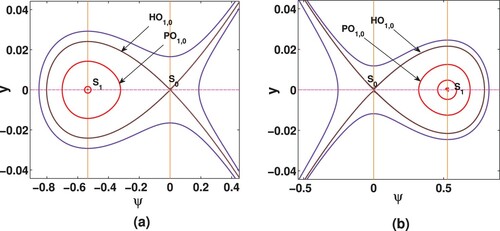
Equation (Equation22(22)
(22) ) can be expressed as
(24)
(24)
where V is the potential energy function corresponding to the DS (Equation23
(23)
(23) ) and it is given by
(25)
(25)
Therefore, the Hamiltonian function (
) corresponding to the DS (Equation23
(23)
(23) ) is given by
(26)
(26)
Considering fixed values of parameters as Figure , we present potential energy function
with respect to ψ in Figure . It is clearly observed from Figures (a,b) that the curves contain one local maximum and minimum points. Figure (a,b) also provides the information of existence of rarefactive and compressive solitary wave solutions shown by two regions traced by the potential curve.
Figure 2. Potential energy function curve of the KdV equation (Equation21(21)
(21) ) with same data values as Figure (a) and (b), respectively.
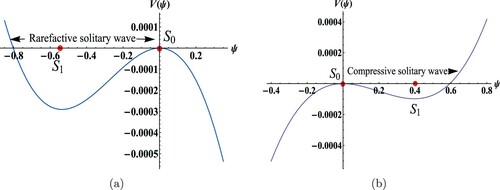
In phase plane analysis, we show nonlinear homoclinic and periodic orbits which correspond to solitary and periodic DIAW solutions, respectively. Thus, we derive analytical form of solitary wave solution of the KdV equation (Equation21(21)
(21) ) as
(27)
(27)
It is clear that height (
) and width (
) of the solitary wave are influenced by system parameters
and β. For A<0, we get rarefactive solitary DIAW, and for A>0, we get compressive solitary DIAW solution. Therefore, in Figure , we show impacts of
and β on RSW and CSW solutions of the KdV equation (Equation21
(21)
(21) ) while other values are fixed as Figure (a,b), respectively. Height of RSW and CSW solutions diminishes as q increases, while, it extends when speed of the wave (v) is increased. We also observe that for higher temperature of ions as compared to electrons, only width of RSW diminishes and there is no significant change in its height. Whereas, both width and height of CSW diminish as temperature of ions rises through the parameter β.
Figure 3. RSW and CSW solutions of the KdV equation (Equation21(21)
(21) ) with same data values as Figure (a,b), respectively.
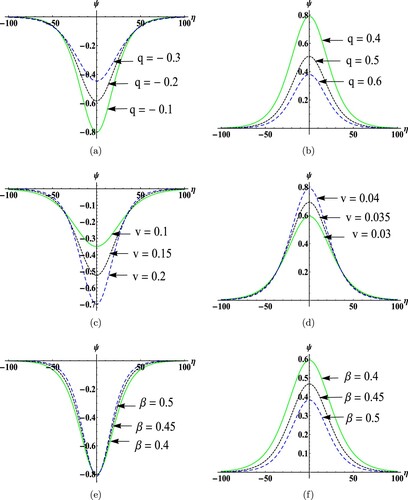
In Figures and , the impacts of and β on PWS are presented numerically in ranges
and 0<q<1, respectively. It is seen that the height of PWS decreases significantly as q increases, while it declines as value of speed of wave (v) is increased. However, with rise in temperature of ions than that of electrons, the height of PWS gradually rises while, its width shrinks as shown in Figure (c). Whereas, under the range 0<q<1 as shown in Figure (c), both height and width of PWS diminish with rise in temperature ratio
.
Figure 4. Periodic solution of the KdV equation (Equation21(21)
(21) ) with same data values as Figure (a).

Figure 5. Periodic solution the KdV equation (Equation21(21)
(21) ) with same data values as Figure (b).
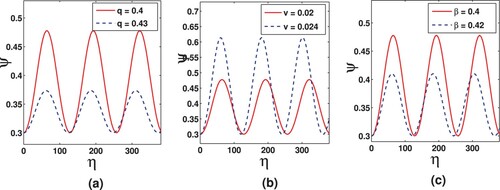
4. Approximate analytical solutions
We can inspect a general nonlinear partial differential equation for
(28)
(28)
where
is to be determined and F is a polynomial consisting of different order partial derivatives of ψ.
The above equation is reduced to a nonlinear ordinary differential equation (ODE)
(29)
(29)
by applying the following transformation
(30)
(30)
with v being the travelling wave velocity. It is to be mentioned that derivative with respect to η is denoted by
. Then, Equation (Equation29
(29)
(29) ) is to be integrated.
The solution to nonlinear ODE is acquired directly by -expansion technique. Some important steps are mentioned below.
4.1. The 
 -expansion technique
-expansion technique
The following steps are mentioned of the -expansion technique [Citation28]:
Step I: Consider the solution of Equation (Equation29(29)
(29) ) in terms of a polynomial in
as
(31)
(31)
where
are unknown constants,
. Here, the linear ODE is
(32)
(32)
which is called auxiliary equation having constants λ and µ.
Step II: Equation (Equation29(29)
(29) ) shows n positive integer obtained by the homogeneous balance between the nonlinear term and the highest order derivative.
Step III: We substitute Equation (Equation31(31)
(31) ) into the nonlinear ODE (Equation29
(29)
(29) ), where
holds Equation (Equation32
(32)
(32) ). Then, collect the terms having like powers of
of the polynomial, where
. Finally, we equate each term of the polynomial and a set of equations in
to zero, where
and λ are to be calculated.
Step IV: Using solutions of Equation (Equation32(32)
(32) ) into (Equation31
(31)
(31) ), we obtain the approximate solutions of (Equation28
(28)
(28) ) after calculating
,
,
.
4.2. Implementation of 
 -expansion technique on DKdV equation
-expansion technique on DKdV equation
In the current section, the -expansion technique is implemented on the DKdV equation (Equation20
(20)
(20) ) to extract approximate analytical solutions. The transformation (Equation30
(30)
(30) ) is considered which reduces Equation (Equation20
(20)
(20) ) to
(33)
(33)
The homogeneous balance between
and
is taken under Equation (Equation33
(33)
(33) ) and obtain the value of the positive integer n as
(34)
(34)
Hence the solution of Equation (Equation33
(33)
(33) ) is assumed in
polynomial as
(35)
(35)
here
holds the auxiliary equation of order 2
(36)
(36)
Finally, we substitute the solution ansatz (Equation35
(35)
(35) ) in (Equation33
(33)
(33) ) considering the auxiliary Equation (Equation36
(36)
(36) ) which yields a
polynomial equation. Collecting all the terms of
and comparing each of them to zero, we get
(37)
(37)
We simplify the set of algebraic Equation (Equation37
(37)
(37) ) and the following
(38)
(38)
where
are constants.
We import the solution in the expression (Equation35(35)
(35) ) and find the general solution as
(39)
(39)
where
.
Finally, the general solution of Equation (Equation36(36)
(36) ) is substituted in the general solution (Equation39
(39)
(39) ) and following travelling wave solutions of Equation (Equation20
(20)
(20) ) are acquired as follows:
The hyperbolic function travelling wave solution for is given by
(40)
(40)
with
and
being arbitrary constants.
The trigonometric function travelling wave solution for is given by
(41)
(41)
where
and
are arbitrary constants.
The rational function solution for is given by
(42)
(42)
where
and
are arbitrary constants.
5. Graphical illustrations
Graphs of the approximate solutions (Equation40(40)
(40) ), (Equation41
(41)
(41) ) and (Equation42
(42)
(42) ) obtained for the DKdV equation are presented by considering different sets of physical parameters q, β,
, λ, µ and
using the Wolfram Mathematica 11.
Figure represents solution (Equation40(40)
(40) ) of the DKdV equation for DIAWs. Here, Figure (a) shows anti 1-soliton solitary wave solution [Citation31] of the DKdV equation with parametric set of
and
. Figure (b) represents solitary wave solutions of kink type with parametric set of
. Figure (c) shows rarefactive solitons with parametric set of
.
Figure 6. 3D graph of Equation (Equation40(40)
(40) ) with (a)
. (b)
. (c)
.
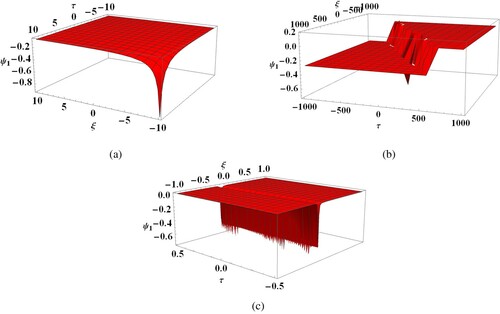
Figure represents the approximate solution (Equation41(41)
(41) ) of the DKdV equation for DIAWs. Here, we clearly observe that Figure (a ,b) represent anti-kink type of solitary wave solution for two different sets of parameters. From Figure (c), it is visible that the solution (Equation41
(41)
(41) ) corresponds to rarefactive periodic solution of the DKdV equation for
.
Figure 7. 3D graph of Equation (Equation41(41)
(41) ) with (a)
. (b)
. (c)
.
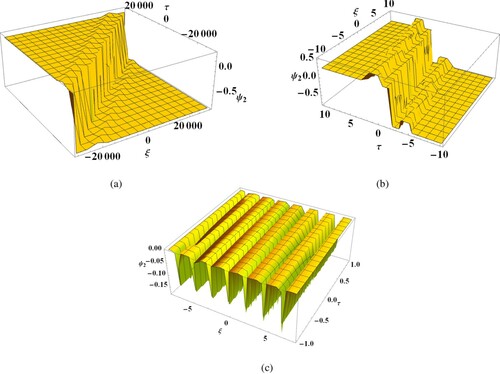
Figure represents the approximate solution (Equation42(42)
(42) ) of the damped KdV equation for DIAWs. It is observed that Figure (a ,b) depict singular kink travelling wave solutions for the DIAWs in
and 0<q<1 ranges, respectively. For range q>1 with
, the solution (Equation42
(42)
(42) ) corresponds to rarefactive solitary wave solution which is clearly observed in Figure (c).
Figure 8. 3D graph of Equation (Equation42(42)
(42) ) with (a)
. (b)
. (c)
.
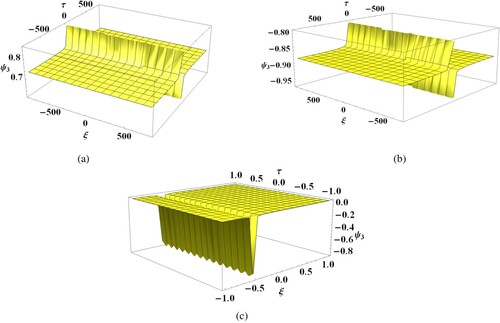
6. Conclusions
The DIAWs in a nonextensive dusty plasma have been analysed under the damped Korteweg–de Vries (DKdV) equation alongside collision between ions and dusts. The DKdV equation has been acquired using the RPT. In the absence of collision between dusts and ions, the damping coefficient has been vanished. In that case, the reduction of the DKdV equation into the KdV equation has been shown. The DS of the KdV equation has been formed to show bifurcation analysis through phase portraits. In this case, the nonextensive parameter q has been the controlling parameter. Potential energy function has been shown for which the dynamical system of the KdV equation shows regions of periodic and solitary wave solutions. For cases and 0<q<1, analytical solitary wave solution and numerical periodic wave solution of the KdV equation for DIAW have been obtained. It has been observed that nonextensive parameter (q), speed of the wave (v) and temperature ratio of ions to electrons
effect the solitary and periodic DIAW solutions. Furthermore, in presence of collisional effect, approximate analytical wave solutions of the DKdV equation have been achieved employing the
-expansion technique. The novel approximate analytical solutions of the DKdV equation have been associated to three different classes, such as, the hyperbolic, trigonometric and rational functions of the travelling wave solutions. It has been perceived that the hyperbolic function solution of DIAW corresponds to anti 1-soliton solitary wave solution, solitary wave solutions of kink type and rarefactive solitary wave solution for different values of q. The trigonometric function solution of DIAW corresponds to anti-kink type of solitary wave with lesser values of q and rarefactive periodic wave for relatively greater values of q. However, the rational function of travelling DIAW solution corresponds to singular kink travelling waves with lesser numbers of q and rarefactive solitary wave with greater numbers of q. The study was carried out considering nonextensive parameter q in the range (
), the number density ratio of electrons and ions (
) as defined by the relation
, and collisional frequency of ions and dusts (
) because of weak collision between dusts and ions, while, other parameters are constants. Generally, collisional effects between particles are delicate, hence, most of the studies neglect all collisional effects on dust-ion-acoustic waves. While, in some cases, collision effects are strong and cannot be avoided. Normally, the collisional frequency between ions and dust grains is larger, while, the collisional frequencies between dusts and electrons, ions and electrons are weak. Therefore, our study can be applicable to many plasma systems, in which electrons and ions have higher mean free paths than the range of the experimental device or pressure of neutral gas is small so that the collisions between neutral atoms and other particles are neglected. The only effective collision occurs between ions and dust grains. Therefore, we neglect the collisions between dusts and electrons, ions and electrons. We only consider the collision effect between ions and dust grains but, assume that the collisional effect is much weak. All the approximate analytical small-amplitude DIAW solutions obtained for the DKdV equation in collisional nonextensive dusty plasmas have not been reported earlier. Therefore, we can conclude that the approximate analytical solutions of the DKdV equation obtained, applying the
-expansion technique, have furnished new and significant solutions which can be of great interest for many researchers in Earth's ionosphere [Citation41, Citation43–46, Citation59].
Disclosure statement
No potential conflict of interest was reported by the author(s).
References
- Shukla PK, Mamun AA. Introduction to dusty plasma physics. Bristol: Institute of Physics Publishing Ltd; 2002.
- Ma JX, Liu J. Dust-acoustic soliton in a dusty plasma. Phys Plasmas. 1997;4:253–255.
- Verheest F. Waves in dusty space plasma. Dordrecht: Kluwer; 2000.
- Mendis DA, Rosenberg M. Cosmic dusty plasma. Annu Rev Astron Astrophys. 1994;32:419–463.
- Shukla PK, Silin VP. Dust ion-acoustic wave. Phys Scr. 1992;45:508–508.
- D'Angelo N. Ion-acoustic waves in dusty plasmas. Planet Space Sci. 1994;42:507–511.
- Nakamura Y, Bailung H, Shukla PK. Observation of ion-Acoustic shocks in a dusty plasma. Phys Rev Lett. 1999;83:1602–1605.
- Luo QZD, Angelo N, Merlino RL. Experimental study of shock formation in a dusty plasma. Phys Plasmas. 1999;6:3455–3458.
- Asagiri H, Muniandy SV, Wong CS. Effects of strength of dispersion and dust density on the formation of solitons and shocks in unmagnetized dusty plasma. Phys Plasmas. 2009;16:073702.
- Ghosh S, Sarkar S, Khan MK, et al. Nonlinear properties of small amplitude dust ion acoustic solitary waves. Phys Plasmas. 2000;7:3594–3599.
- Losseva TV, Popel SI, Golub AP, et al. Evolution of weakly dissipative hybrid dust ion-acoustic solitons in complex plasmas. Phys Plasmas. 2009;16:093704.
- Roychowdhury K, Mishra AP, Roychowdhury A. Solitary waves in a dusty plasma with charge fluctuation and dust size distribution and vortex like ion distribution. Chaos, Solitons Fractals. 2006;29:125–130.
- Popel SI, Losseva TV, Golub AP, et al. Dust ion-Acoustic shocks in a Q machine device. Contrib Plasma Phys. 2005;45:461–475.
- Losseva TV, Popel SI, Golub AP, et al. Weakly dissipative dust-ion-acoustic solitons in complex plasmas and the effect of electromagnetic radiation. Phys Plasmas. 2012;19:013703.
- Kruskal M. Nonlinear wave equations in dynamical systems. In: Moser J, editor. Theory and applications. Heidelberg: Springer-Verlag; 1975. p. 310–354. (Lecture Notes in Physics; 38).
- Alinejad H. Dust ion-acoustic solitary and shock waves in a dusty plasma with non-thermal electrons. Astrophys Space Sci. 2010;327:131–137.
- El-Taibany WF, El-Bedwehy NA, El-Shamy EF. Three-dimensional stability of dust-ion acoustic solitary waves in a magnetized multicomponent dusty plasma with negative ions. Phys Plasmas. 2011;18:033703.
- Barkan AD, Angelo N, Merlino RL. Experiments on ion-acoustic waves in dusty plasmas. Planet Space Sci. 1996;44:239–242.
- Ferdousi M, Miah MR, Sultana S, et al. Low-Frequency electrostatic shock excitations in a multi-component dusty plasma. Braz J Phys. 2015;45:244–250.
- Ashraf S, Yasmin S, Asaduzzaman M, et al. Obliquely propagating nonextensive dust-ion-acoustic solitary waves in a dusty magnetoplasma. Astrophys Space Sci. 2013;344:145–151.
- Bacha M, Tribeche M, Shukla PK. Dust ion-acoustic solitary waves in a dusty plasma with nonextensive electrons. Phys Rev E. 2012;85:056413.
- Tribeche M, Zerguini TH. Current-driven dust ion-acoustic instability in a collisional dusty plasma with charge fluctuations. Phys Plasmas. 2001;8:394–398.
- Maitra S, Banerjee G. Dust ion acoustic solitary waves in a collisional dusty plasma with dust grains having Gaussian distribution. Phys Plasmas. 2014;21:113707.
- Janaki MS, Dasgupta B, Gupta MR, et al. Solitary magnetosonic waves with Landau damping. Phys Scr. 1992;45:368–372.
- Ghosh S, Chaudhuri TK, Sarkar S, et al. Collisionless damping of nonlinear dust ion acoustic wave due to dust charge fluctuation. Phys Rev E. 2002;65:037401.
- Ghosh S, Adak A, Khan M. Dissipative solitons in pair-ion plasmas. Phys Plasmas. 2014;21:012303.
- Chatterjee P, Ali R, Saha A. Analytical solitary wave solution of the dust ion acoustic waves for the damped forced Korteweg-de Vries equation in superthermal plasmas. Zeitschrift Für Naturforschung A. 2018;73:151–159.
- Wang ML, Li XZ, Zheng JL. The (G'/G)-expansion method and travelling wave solutions of nonlinear evolution equations in mathematical physics. Phys Lett A. 2008;372:417–423.
- Zhang J, Wei X, Lu Y. A generalized (G'/G)-expansion method and its applications. Phys Lett A. 2008;372:3653–3658.
- Zhang J, Jiang F, Zhao X. An improved (G'/G)-expansion method for solving nonlinear evolution equations. Int J Comput Math. 2010;87:1716–1725.
- Hafez MG, Akbar MA. Exact traveling wave solutions to the Klein-Gordon equation using the novel (G'/G)-expansion method. Results Phys. 2014;4:177–184.
- Sahoo S, Ray SS. Solitary wave solutions for time fractional third order modified KdV equation using two reliable techniques (G'/G)-expansion method and improved (G'/G)-expansion method. Phys A. 2016;448:265–282.
- Mehdipoor M. The characteristics of ion acoustic shock waves in non-Maxwellian plasmas with (G'/G)-expansion method. Astrophys Space Sci. 2012;338:73–79.
- Mehdipoor M, Neirameh A. New exact solutions for nonlinear solitary waves in Thomas-Fermi plasmas with (G'/G)-expansion method. Astrophys Space Sci. 2012;337:269–274.
- Tsallis C. Possible generalization of Boltzmann–Gibbs statistics. J Stat Phys. 1988;52:479–487.
- Tsallis C. In new trends in magnetism. In: Moran-Lopez JL, Sanchez JM, editors. Magnetic materials and their applications. New York: Plenum; 1994. p. 451.
- Tsallis C. Some comments on Boltzmann-Gibbs statistical mechanics. Chaos, Solitons Fractals. 1995;6:539–559.
- Lima JAS, Silva R, Santos Jr J. Plasma oscillations and nonextensive statistics. Phys Rev E. 2000;61:3260–3263.
- Liu JM, De Groot JS, Matt JP, et al. Measurements of inverse bremsstrahlung absorption and non-Maxwellian electron velocity distributions. Phys Rev Lett. 1994;72:2717–2720.
- Du JL. Nonextensivity in nonequilibrium plasma systems with Coulombian long-range interactions. Phys Lett A. 2004;329:262–267.
- Ghosh DK, Mandal G, Chatterjee P, et al. Nonplanar ion acoustic solitary waves in electron-Positron-Ion plasma with warm ions, and electron and positron following Q-Nonextensive velocity distribution. IEEE Trans Plasma Sci. 2013;41:1600–1606.
- Taruya A, Sakagami MA. Long-Term evolution of stellar self-Gravitating systems away from thermal equilibrium: connection with nonextensive statistics. Phys Rev Lett. 2003;90:181101.
- Munoz V. A nonextensive statistics approach for Langmuir waves in relativistic plasmas. Nonlinear Processes Geophys. 2006;13:237–241.
- Pakzad HR. Effect of q-nonextensive distribution of electrons on electron acoustic solitons. Astrophys Space Sci. 2011;333:247–255.
- Latora V, Rapisarda A, Tsallis C. Non-Gaussian equilibrium in a long-range Hamiltonian system. Phys Rev E. 2001;64:056134.
- Eslami P, Mottaghizadeh M, Pakzad HR. Head-on collision of ion-acoustic solitary waves in a plasma with a q-nonextensive electron velocity distribution. Phys Scr. 2011;84:015504.
- Ghosh UN, Ghosh DK, Chatterjee P, et al. Nonplanar ion-acoustic gardner solitons in a pair-ion plasma with nonextensive electrons and positrons. Astrophys Space Sci. 2013;343:265–272.
- Rehman A, Ahmad M, Hamza MY. Effect of non-extensivity parameter q on the damping rate of dust ion acoustic waves in non?extensive dusty plasma. Contrib Plasma Phys. 2019;59:54–62.
- El Ghani O, Driouch I, Chatei H. Effects of non-extensive electrons on the sheath of dusty plasmas with variable dust charge. Contrib Plasma Phys. 2019;59:e201900030.
- Bains AS, Tribeche M, Gill TS. Modulational instability of ion-acoustic waves in a plasma with a q-nonextensive electron velocity distribution. Phys Plasmas. 2011;18:022108.
- Samanta UK, Saha A, Chatterjee P. Bifurcations of dust ion acoustic travelling waves in a magnetized dusty plasma with a q-nonextensive electron velocity distribution. Plasma. 2013 Phys;20:022111.
- Selim MM, El-Depsy A, El-Shamy EF. Bifurcations of nonlinear ion-acoustic travelling waves in a multicomponent magnetoplasma with superthermal electrons. Astrophys Space Sci. 2015;360:8893.
- Saha A, Chatterjee P. Solitonic, periodic, quasiperiodic and chaotic structures of dust ion acoustic waves in nonextensive dusty plasmas. Eur Phys J D. 2015;69:395.
- Saha A, Chatterjee P. Solitonic, periodic and quasiperiodic behaviors of dust ion acoustic waves in superthermal plasmas. Braz J Phys. 2015;45:419–426.
- El-Monier SY, Atteya A. Bifurcation analysis for dust-Acoustic waves in a four-Component plasma including warm ions. IEEE Trans Plasma Sci. 2018;46:815–824.
- Tamang J, Sarkar K, Saha A. Solitary wave solution and dynamic transition of dust ion acoustic waves in a collisional nonextensive dusty plasma with ionization effect. Phys A. 2018;505:18–34.
- Strogatz SH. Nonlinear dynamics and chaos. Kolkata: Levant Books; 2007.
- Seadawy AR, Iqbal M, Lu D. Propagation of kink and anti-kink wave solitons for the nonlinear damped modified Korteweg-de Vries equation arising in ion-acoustic wave in an unmagnetized collisional dusty plasma. Phys A. 2020;544:123560.
- Bouchoule A. Dusty plasmas. New York: Wiley; 1999.
